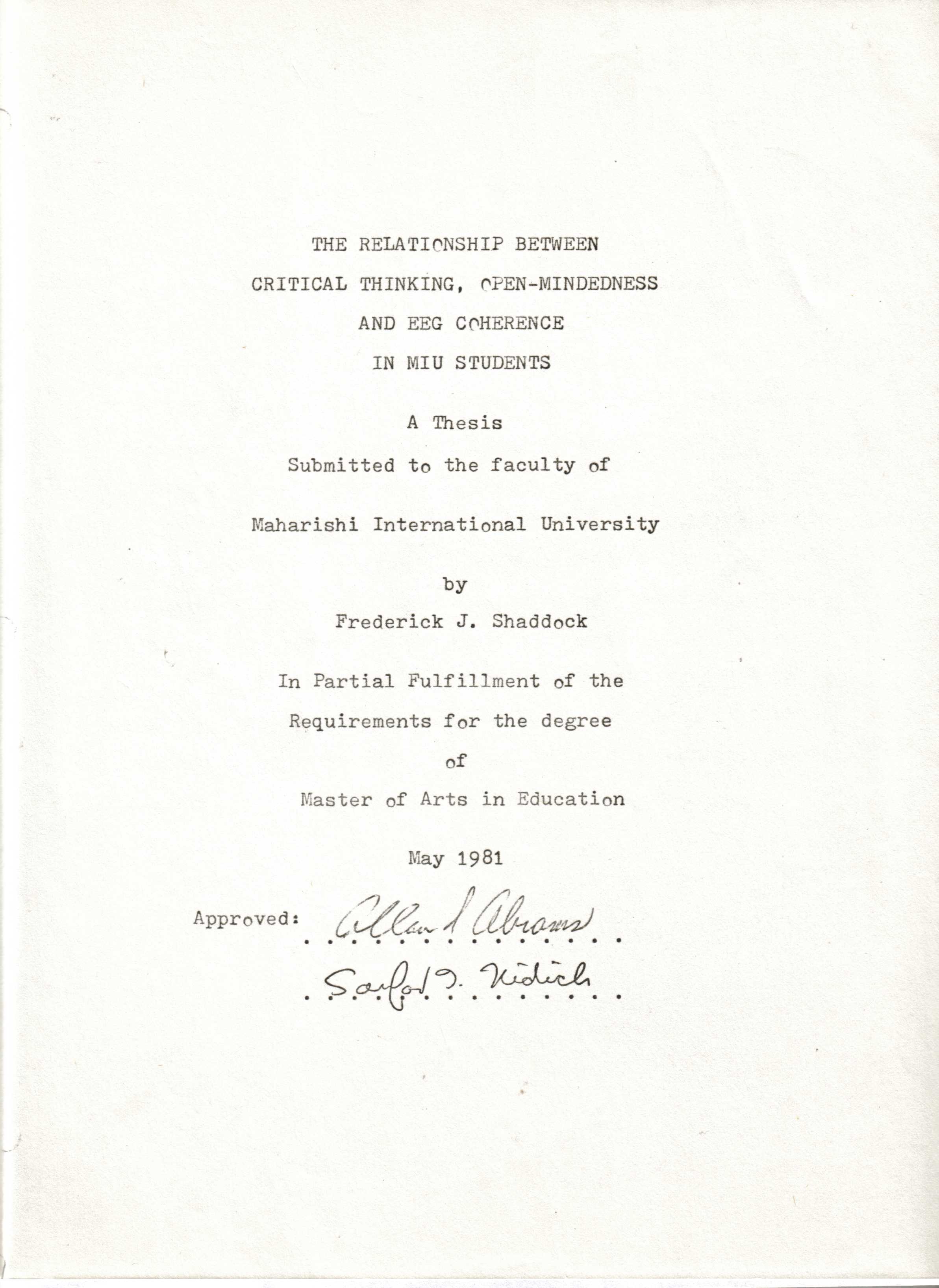
ctomeegmiu0.jpg
|
THE RELATIONSHIP BETWEEN
CRITICAL THINKING, OPEN-MINDEDNESS
AND EEG COHERENCE
IN MIU STUDENTS
A Thesis
Submitted to the faculty of
Maharishi International University
by
Frederick J. Shaddock
In Partial Fulfillment of the
Requirements for the degree
of
Master of Arts in Education
May 1981
Approved: Allan I. Abrams
Sanford I. Nidich |
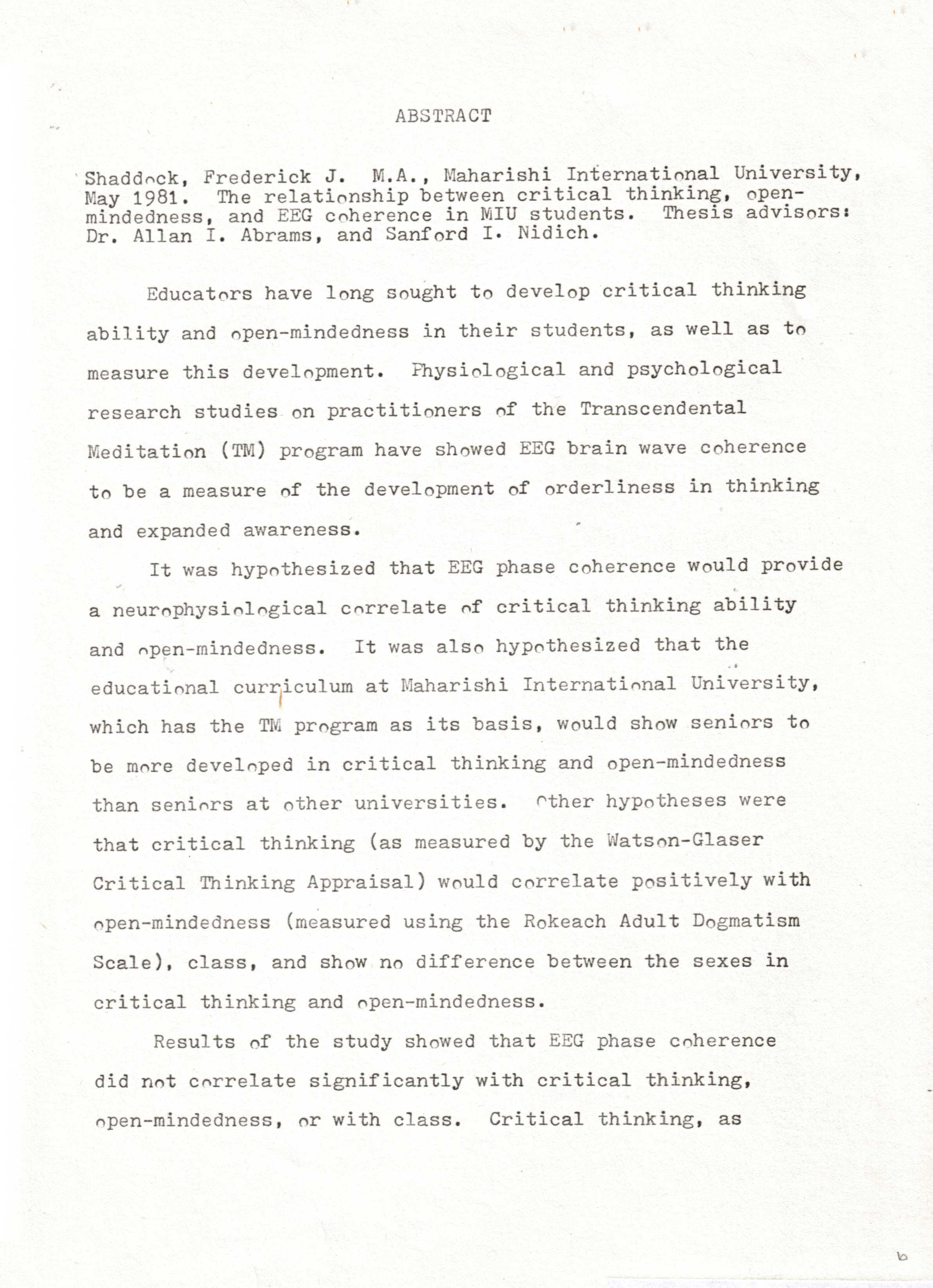
ctomeegmiu00ab1.jpg
|
ABSTRACT
Shaddock, Frederick J. M.A., Maharishi International
University, May 1981. The relationship between critical thinking,
open-mindedness, and EEG coherence in MIU students. Thesis advisors: Dr.
Allan I. Abrams, and Sanford I. Nidich.
Educators have long sought to develop critical thinking ability and
open-mindedness in their students, as well as to measure this development.
Physiological and psychological research studies on practitioners of the
Transcendental Meditation (TM) program have showed EEG brain wave coherence to
be a measure of the development of orderliness in thinking and expanded
awareness.
It
was hypothesized that EEG phase coherence would provide a neurophysiological
correlate of critical thinking ability and open-mindedness. It was also
hypothesized that the educational curriculum at Maharishi International
University, which as the TM program as its basis, would show seniors to be
more developed in critical thinking and open-mindedness than seniors at other
universities. Other hypotheses were that critical thinking (as measured by
the Watson-Glaser Critical Thinking Appraisal) would correlate positively with
open-mindedness (measured using the Rokeach Adult Dogmatism Scale), class, and
show no difference between the sexes in critical thinking and open-mindedness.
Results of the study showed that EEG phase coherence did not correlate
significantly with critical thinking, open-mindedness, or with class. Critical
thinking, as
|
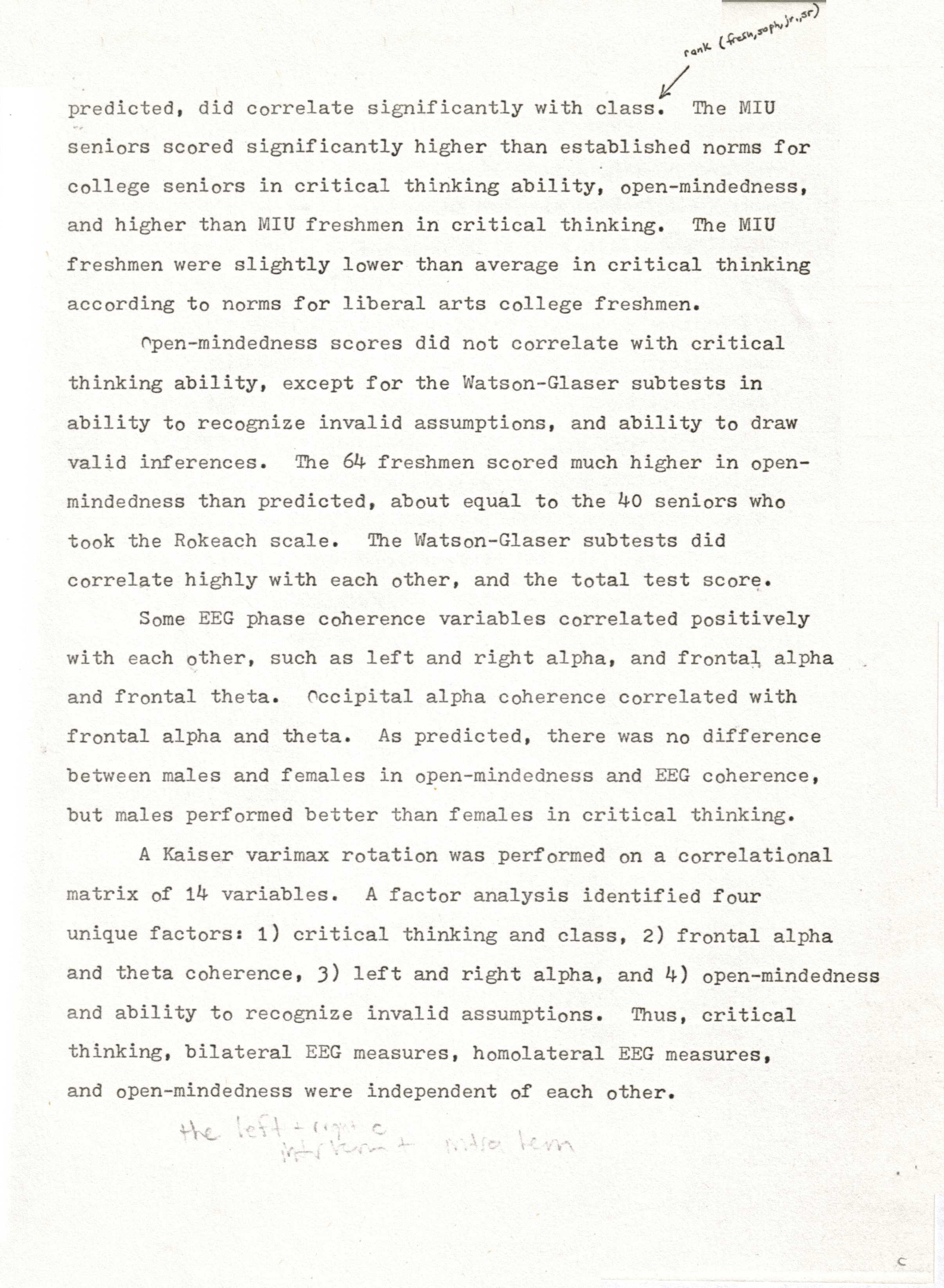
ctomeegmiu00ab2.jpg
|
predicted, did correlate significantly
with class. The MIU seniors scored significantly higher than established
norms for college seniors in critical thinking ability, open-mindedness, and
higher than MIU freshmen in critical thinking. The MIU freshmen were
slightly lower than average in critical thinking according to norms for liberal
arts college freshmen.
Open-mindedness
scores did not correlate with critical thinking ability, except for the
Watson-Glaser subtests in ability to recognize invalid assumptions, and ability
to draw valid inferences. The 64 freshmen scored much higher in
open-mindedness than predicted, about equal to the 40 seniors who took the
Rokeach scale. The Watson-Glaser subtests did correlate highly with each
other and the total test score.
Some EEG phase
coherence variables correlated positively with each other, such as left and
right alpha, and frontal alpha and frontal theta. Occipital alpha
coherence correlated with frontal alpha and theta. As predicted, there was
no difference between males and females in open-mindedness and EEG coherence,
but males performed better than females in critical thinking.
A Kaiser varimax
rotation was performed on a correlational matrix of 14 variables. A factor
analysis identified four unique factors: 1) critical thinking and class, 2)
frontal alpha and theta coherence, 3) left and right alpha, and 4)
open-mindedness and ability to recognize invalid assumptions. Thus,
critical thinking, bilateral EEG measures, homolateral EEG measures, and
open-mindedness were independent of each other. |
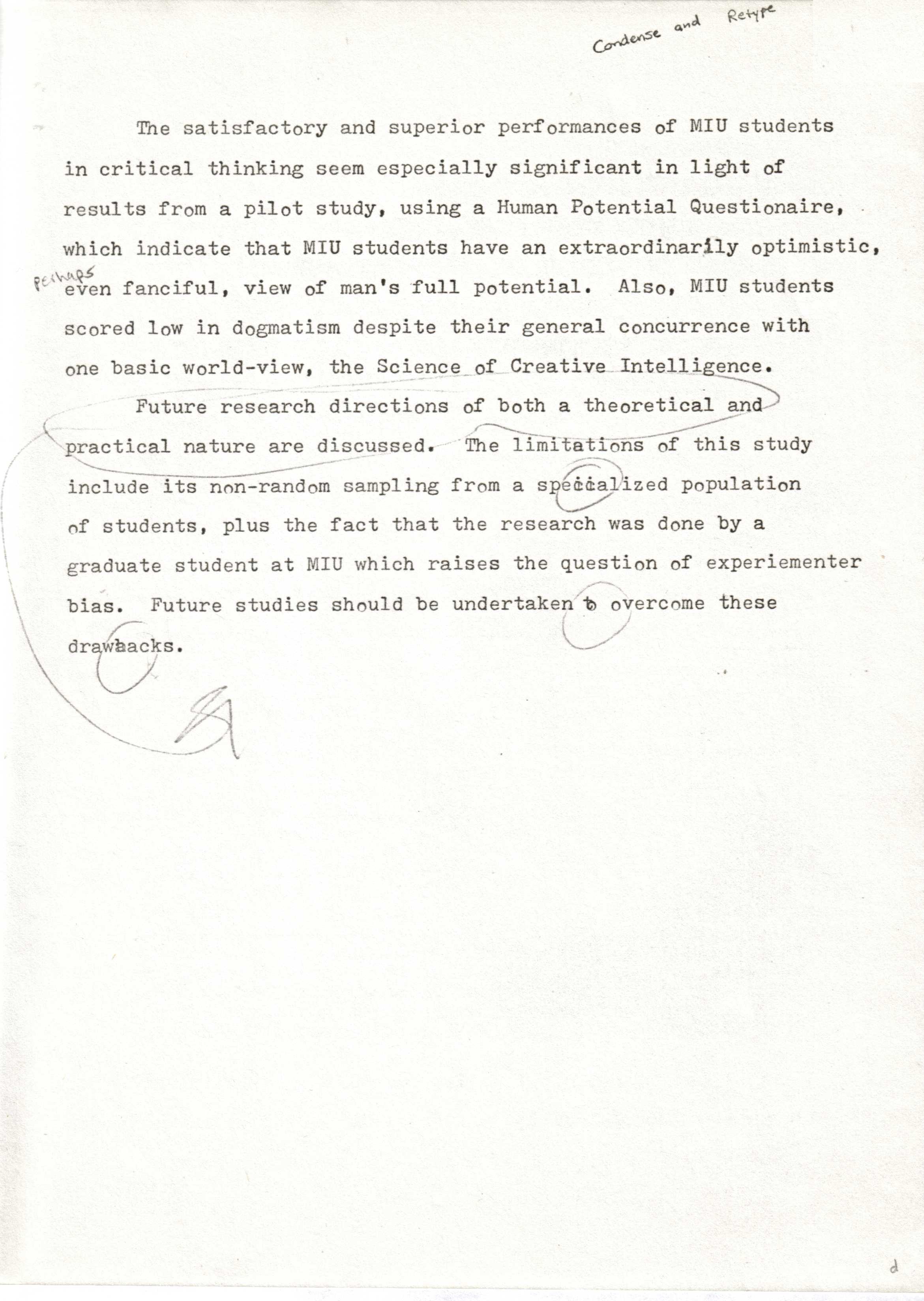
ctomeegmiu00ab3.jpg
|
The satisfactory and
superior performances of MIU students in critical thinking seem especially
significant in light of results from a pilot study, using a Human Potential
Questionnaire, which indicate that MIU students have an extraordinarily
optimistic, perhaps even fanciful, view of man's full potential. Also, MIU
students scored low in dogmatism despite their general concurrence with one
basic world-view, the Science of Creative Intelligence.
Future research
directions of both a theoretical and practical nature are discussed. The
limitations of this study include its non-random sampling from a specialized
population of students, plus the fact that the research was done by a graduate
student at MIU which raises the question of experimenter bias. Future
studies should be undertaken to overcome these drawbacks. |
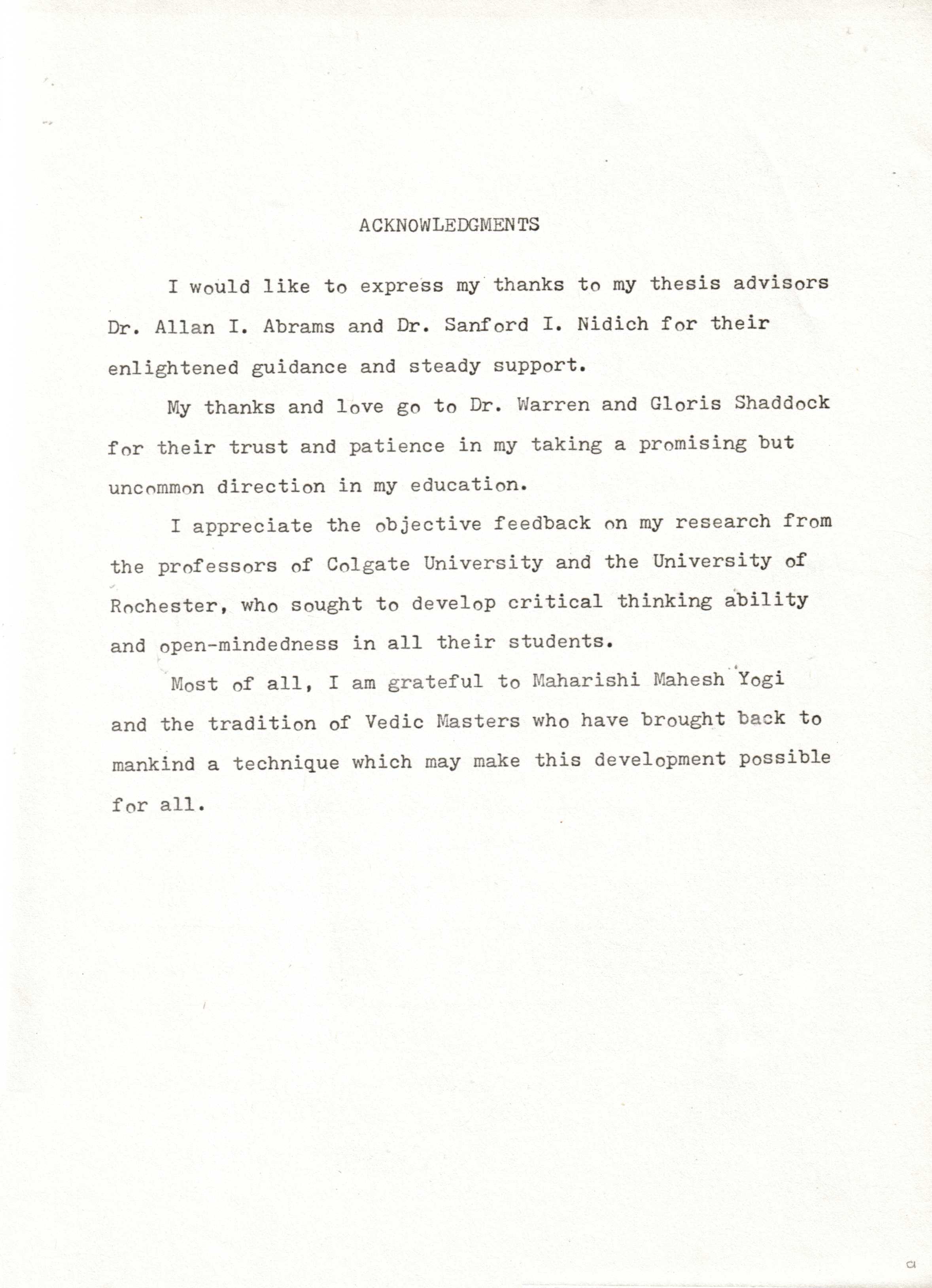 |
ACKNOWLEDGMENTSI
would like to express my thanks to my thesis advisors Dr. Allan I. Abrams and
Dr. Sanford I. Nidich, as well as Dr. Susan Levin Dillbeck, for their
enlightened guidance and steady support.
My thanks and love go
to Dr. Warren and Gloris Shaddock for their trust and patience in my taking a
promising but uncommon direction in my education.
I appreciate the
objective feedback on my research from the professors of Colgate University and
the University of Rochester, who sought to develop critical thinking ability
and open-mindedness in all their students.
Most of all, I am
grateful to Maharishi Mahesh Yogi and the tradition of Vedic Masters who have
brought back to mankind a technique which may make this development possible
for all.
|
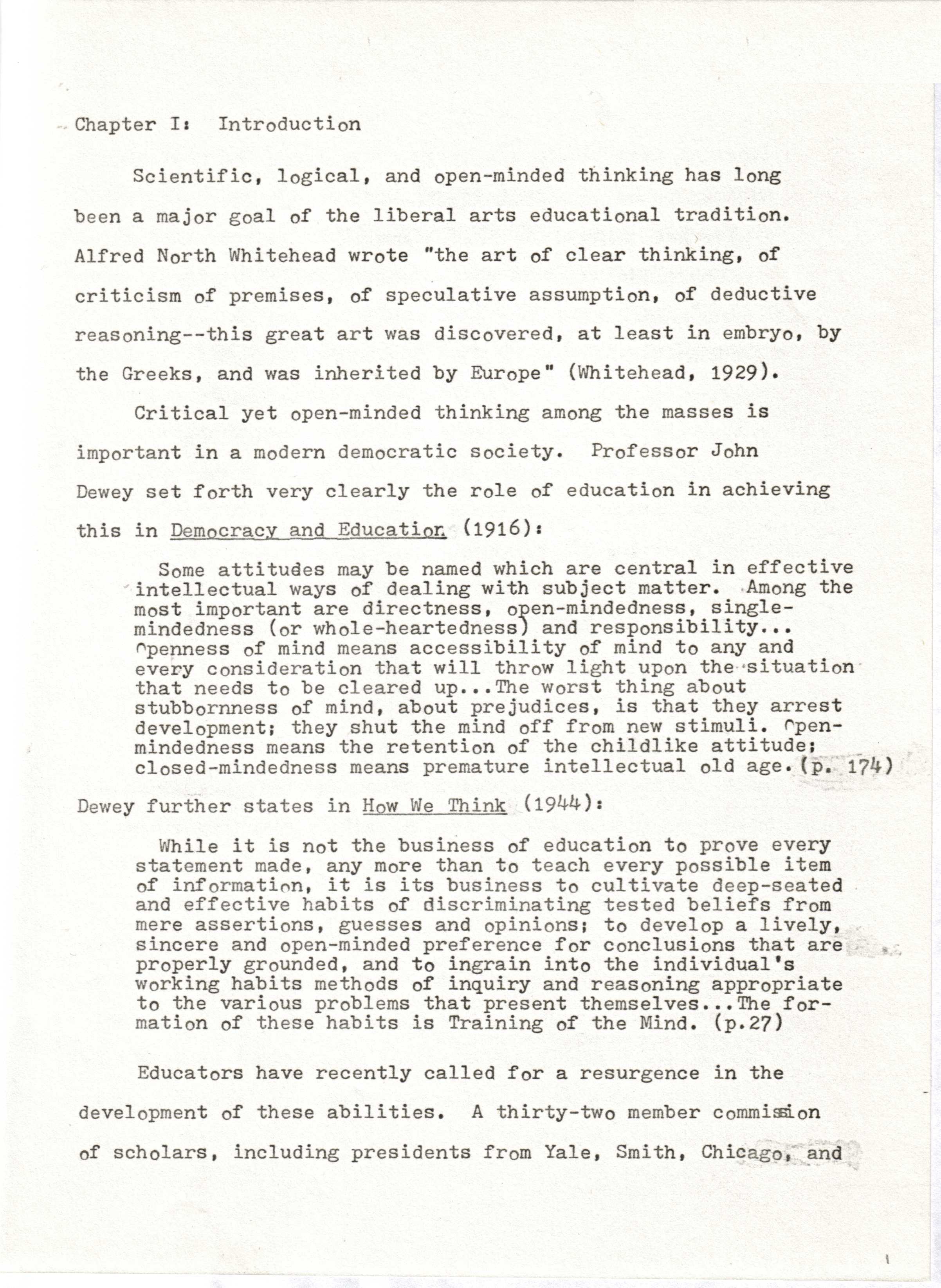
ctomeegmiu01intro.jpg
|
Chapter I: Introduction
Scientific, logical,
and open-minded thinking has long been a major goal of the liberal arts
educational tradition. Alfred North Whitehead wrote "the art of clear
thinking, of criticism of premises, of speculative assumption, of deductive
reasoning--this great art was discovered, at least in embryo, by the Greeks, and
was inherited by Europe" (Whitehead, 1929).
Critical yet
open-minded thinking among the masses is important in a modern democratic
society. Professor John Dewey set forth very clearly the role of education
in achieving this in Democracy and Education (1916).
- Some attitudes may be named which
are central in effective intellectual ways of dealing with subject matter.
Among the most important are directedness, open-mindedness, single-mindedness
(or whole-heartedness) and responsibility... Openness of mind means
accessibility of mind to any and every consideration that will throw light
upon the situation that needs to be cleared up... The worst thing about
stubbornness of mind, about prejudices, is that they arrest development; they
shut the mind off from new stimuli. Open-mindedness means the retention
of the childlike attitude; closed-mindedness means premature intellectual old
age. (p.174)
Dewey further states
in How We Think (1944):
- While it is not the business of education to prove every statement made, any
more than to teach every possible item of information, it is its business to
cultivate deep-seated and effective habits of discriminating tested beliefs
from mere assertions, guesses and opinions; to develop a lively, sincere and
open-minded preference for conclusions that are properly grounded, and to
ingrain into the individual's working habits methods of inquiry and
reasoning appropriate to the various problems that present themselves... The
formation of these habits is Training of the Mind. (p.27)
Educators have recently called for a resurgence in the development of these
abilities. A thirty-two member commission of scholars, including
presents from Yale, Smith, Chicago, and
|
 78 pages
78 pages 




